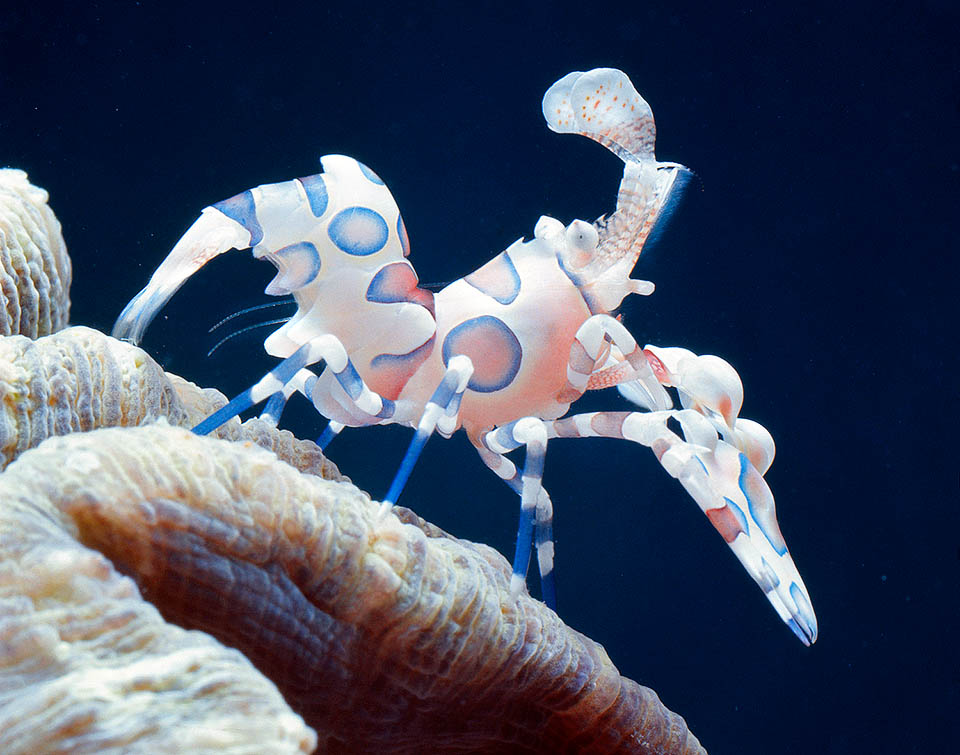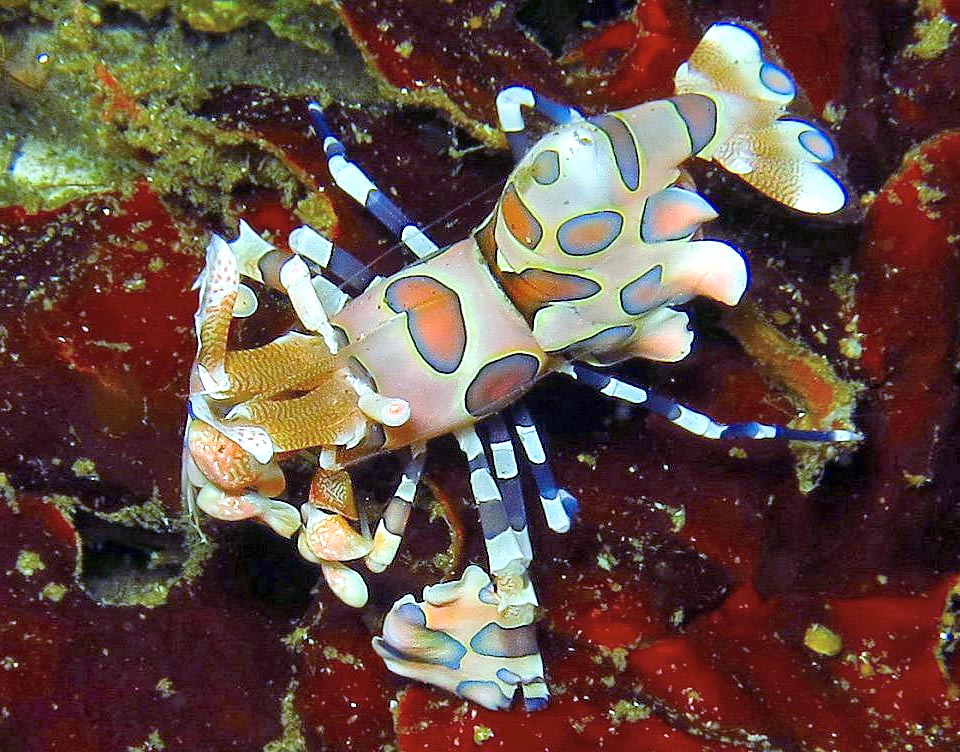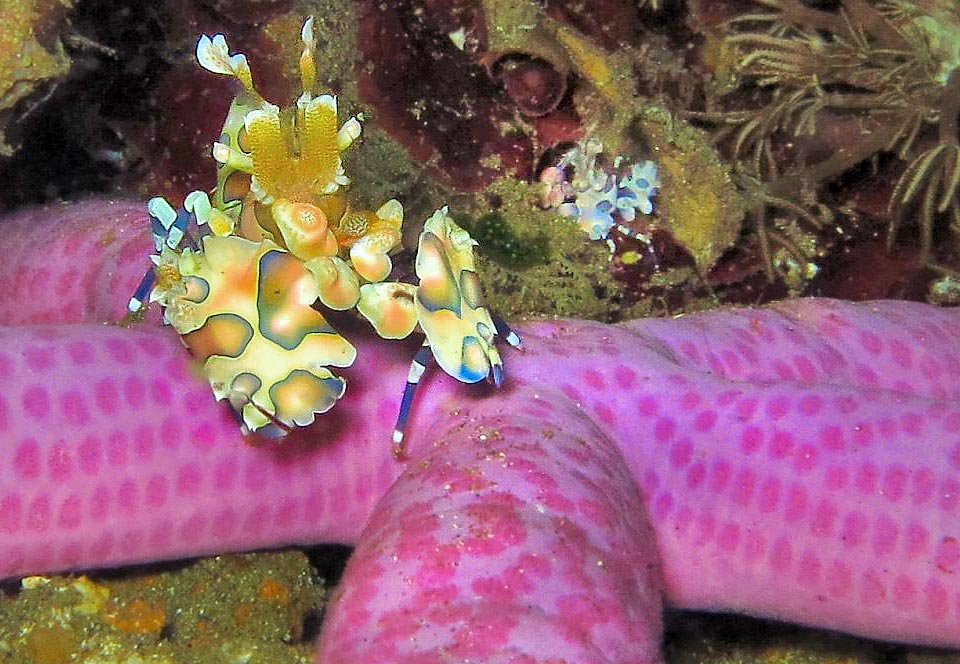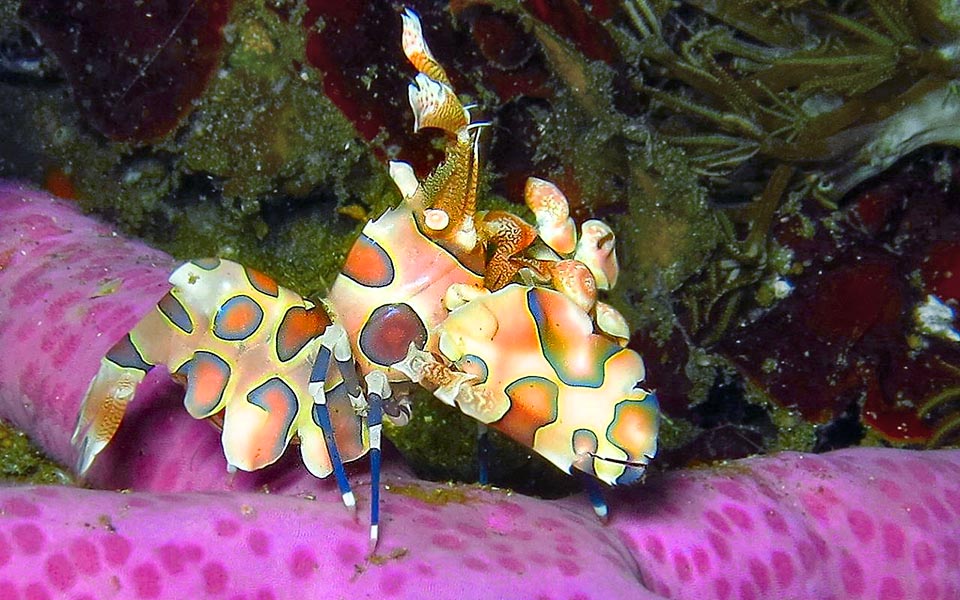Family : Hymenoceridae

Text © Sebastiano Guido

English translation by Mario Beltramini

The Harlequin shrimp (Hymenocera picta) is common in the Indo-Pacific, Red Sea included. Its drawing and form are perfectly mimetic with the environment where it lives. The colour and spots, blue with pink centre or red, are quite variable. It is a territorial species living, at least seasonally, in pair. It’s the female, bigger than the male, to keep the family united freeing recall pheromones. Weddings are preceded by a particular sexy dance, that highlights, moving them, the sexual organs © Giuseppe Mazza
The Harlequin shrimp (Hymenocera picta Dana,1852) belongs to the class of the Malacostraca, crustaceans with head composed by 5 segments, whilst the chest and abdomen respectively have 8 and 6 (plus the telson), to the order of the Decapoda and to the family of the Hymenoceridae, that has only one genus and one only species.
The name of the genus Hymenocera comes from the Greek words “hymen” (membrane, pellicle) and “keras” (horns, or in our case antennae) thus indicating that the crustacean has lamina-shaped antennae. The name of the species, picta comes from the Latin “pictus”, past participle of “pingere” (to paint) and puts in evidence the coloured spots adorning the exoskeleton of the decapod. Also the Italian name, that refers to English harlequin shrimp, highlights the look of the spotted “dress” that covers the animal, comparing it to the Bergamo mask.
Zoogeography
This crustacean lives in the coral areas of the Indian and Pacific Oceans, from Red Sea and the African coasts up to South Africa and the faraway islands of Polynesia. Are included in this zone all the coasts of the Asian continent, up to south of Japan, good part of the tropical and subtropical coats of Australia and all the archipelagoes and islands included in the perimeter of these lands.
Ecology-Habitat
The Harlequin shrimp prefers the coral reefs, among which it loves to hide, to consume its choice food in complete tranquility: the starfish.

A seabed with rhodophytes and debris, rich of ravines to hide, is the ideal habitat for the Harlequin shrimp © Sebastiano Guido
Usually it lives in pair with a partner with whom links indissolubly. Difficult to find due to its mimicry, the size and the shy habits, it can be met more frequently at depths between the 5 and the 40 m, even if the bathymetry may vary depending on the populations of echinoderms present in zone.
Morphophysiology
The most eye-catching characteristics of the decapod that usually does not surpass the 5 cm, are the large spots of irregular shape that dot the carapace, the abdomen and the large claws. Two, smaller and roundish, adorn also the uropods, that have an essential function for backwards swimming.
The colour of the spots goes from pink to reddish, to light blue and violet, with edge usually darker or bluish. The background colour is pearly white, with diffused nuances that vary individually from yellowish to light bluish and pinkish. The legs, with sharp small nail, have 4 or 5 dark bands, concolourous to the spots of the body, interrupted near the joints by whitish bands usually less extended.
The claws are very characteristic, flat and often lobate on the perimeter, have the outer mobile part (dactylopodite) disproportionately narrower than the inner part (propodite). Also the antennae are unusual. They have a flattened lamellar form and are articulated in the central part. They are helped by a couple of antennulae, that display three thin inverted cups each, and two very fine bristles combs. They are all sensory organs that allow the crustacean to smell and “taste” the surrounding world and locate easily the prey.

The Hymenocera picta eats mainly starfishes and if doesn’t find them of modest size, attacks in pair even big species, like the infamous Acanthaster plancii, devourer of corals and the Protoreaster nodosus. Here a female in foreground, with the male not far at its right, prepares to dissect a Linckia laevigata © Sebastiano Guido
The terminal zone of the antennae is very mobile and adjustable and has a sparse brown dotting that, while going down towards the eyes, thickens transforming in a whole of thin wavy lines. The same pattern is partially present also on the antennulae and on the uropods. Just behind the odd antennae (comparable to the eyes of the vile coyote of the comics) with the eyes protruding from a long peduncle. They are diagonally extended laterally and between them passes the short serrated rostrum that starts from the middle of the carapace. The abdomen has the swimming pleopods.
There is no evident sexual dimorphism excepting the dimensions that are greater in the females.
Ethology-Reproductive Biology
The reproductive period coincides with the female’s mounting and is difficult to be observed because, in this crucial time for their existence, the crustaceans, no longer protected by the armor, are an easy prey of their natural foes and to defend themselves they take refuge into their inaccessible hideouts of the coral reef. Observations done in this environment have revealed that the mating begins within an hour from when the female is defenseless, with the emission of the eggs and their fertilization.
Like most of crustaceans, she will carry them stuck to the abdomen for a couple of weeks. At 28 degrees of temperature the time of hatching may vary from 13 to 16 days, after which the larvae will get out from the eggs to begin a swimming life that will end when the survivors will settle in an area that will be their residence for the remainder of their adult life.

The claw is ready to work. They eventually will end up in detaching one arm to carry then to their shelter to eat it quite calmly © Sebastiano Guido
The couples that will form are territorial and defend their area against the conspecifics. The two partners will live in common and will help each other especially in hunting.
Their usual preys are the small and medium-sized starfishes, with a special predilection for the Linckia laevigata. Equally appreciated are the various species of Fromia and Asterina and, in the absence of something else, even the large starfishes Acanthaster planci or Protoreaster nodosus and, even some sea urchin form a fall-back menu. The harlequin shrimp in fact nourishes of the soft parts of the various echinoderms, privileging the pedicels and the aquifer channel. When the prey is very big, after having overturned it, the couple of crustaceans, that acts in a team also for this tiring operation, will amputate one arm and will carry it to its own shelter to eat it in all tranquility. The disabled starfish will be able to escape getting out from the territory of the Hymenocera picta and, if will not make new unfortunate encounters, will have the missing arm growing again.
Fishes, pulps, crabs and other big crustaceans like the Odontodactylus scyllarus, known as “clown mantis shrimp”, stand among the most common foes of the shrimp, who however, due to its showy colouration suggests that, although this has not yet been ascertained, to have toxic flesh or at least of disgusting taste.
Even if of difficult breeding due to its particular diet, the harlequin shrimp is in great demand from the aquarium market that appreciates its singular beauty thus contributing, unluckily, to its rarefaction in nature.
Synonyms
Hymenocera elegans Heller, 1861; Hymenocera latreillii Sharp, 1893.
→ To appreciate the biodiversity within the CRUSTACEANS please click here.
